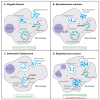Autophagy and Lc3-Associated Phagocytosis in Zebrafish Models of Bacterial Infections
- PMID: 33138004
- PMCID: PMC7694021
- DOI: 10.3390/cells9112372
Autophagy and Lc3-Associated Phagocytosis in Zebrafish Models of Bacterial Infections
Abstract
Modeling human infectious diseases using the early life stages of zebrafish provides unprecedented opportunities for visualizing and studying the interaction between pathogens and phagocytic cells of the innate immune system. Intracellular pathogens use phagocytes or other host cells, like gut epithelial cells, as a replication niche. The intracellular growth of these pathogens can be counteracted by host defense mechanisms that rely on the autophagy machinery. In recent years, zebrafish embryo infection models have provided in vivo evidence for the significance of the autophagic defenses and these models are now being used to explore autophagy as a therapeutic target. In line with studies in mammalian models, research in zebrafish has shown that selective autophagy mediated by ubiquitin receptors, such as p62, is important for host resistance against several bacterial pathogens, including Shigella flexneri, Mycobacterium marinum, and Staphylococcus aureus. Furthermore, an autophagy related process, Lc3-associated phagocytosis (LAP), proved host beneficial in the case of Salmonella Typhimurium infection but host detrimental in the case of S. aureus infection, where LAP delivers the pathogen to a replication niche. These studies provide valuable information for developing novel therapeutic strategies aimed at directing the autophagy machinery towards bacterial degradation.
Keywords: Cyba; Dram1; LAP; Optn; Rubcn; autophagy; innate immunity; p62; tuberculosis zebrafish.
Conflict of interest statement
The authors declare no conflict of interest.
Figures



References
Publication types
MeSH terms
Substances
LinkOut - more resources
Full Text Sources
Medical
Research Materials

